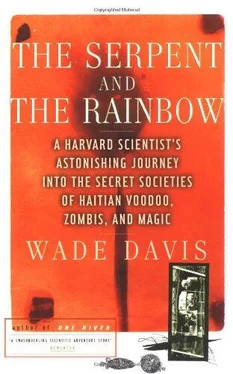Wade Davis - The Serpent and the Rainbow
Здесь есть возможность читать онлайн «Wade Davis - The Serpent and the Rainbow» весь текст электронной книги совершенно бесплатно (целиком полную версию без сокращений). В некоторых случаях можно слушать аудио, скачать через торрент в формате fb2 и присутствует краткое содержание. Год выпуска: 1985, Издательство: Simon & Schuster, Жанр: Старинная литература, на английском языке. Описание произведения, (предисловие) а так же отзывы посетителей доступны на портале библиотеки ЛибКат.
- Название:The Serpent and the Rainbow
- Автор:
- Издательство:Simon & Schuster
- Жанр:
- Год:1985
- ISBN:нет данных
- Рейтинг книги:5 / 5. Голосов: 1
-
Избранное:Добавить в избранное
- Отзывы:
-
Ваша оценка:
- 100
- 1
- 2
- 3
- 4
- 5
The Serpent and the Rainbow: краткое содержание, описание и аннотация
Предлагаем к чтению аннотацию, описание, краткое содержание или предисловие (зависит от того, что написал сам автор книги «The Serpent and the Rainbow»). Если вы не нашли необходимую информацию о книге — напишите в комментариях, мы постараемся отыскать её.
The Serpent and the Rainbow — читать онлайн бесплатно полную книгу (весь текст) целиком
Ниже представлен текст книги, разбитый по страницам. Система сохранения места последней прочитанной страницы, позволяет с удобством читать онлайн бесплатно книгу «The Serpent and the Rainbow», без необходимости каждый раз заново искать на чём Вы остановились. Поставьте закладку, и сможете в любой момент перейти на страницу, на которой закончили чтение.
Интервал:
Закладка:
Powerful is perhaps an understatement. Virtually any contemporary victim of heart disease depends on a daily dose of digitalis, a drug extracted from the common European foxglove, a plant used as a cardiotonic in England since the tenth century. Bufotoxin and bufogenin have been found to be fifty to one hundred times more potent than digitalis. What does this mean? When a cat, in one experiment, was injected with as little as one-fiftieth of a gram of crude ch’an su, its blood pressure tripled almost immediately, and then it collapsed following massive heart failure. If a human responded in the same way, this would mean that as little as half a gram of dried venom applied intravenously would do similar punishment to a 150-pound man. Applied topically, one would at least expect a rapid increase in blood pressure. A quick glance at my list of Narcisse’s symptoms allowed me to draw a line between Bufo marinus and hypertension.
Given the toxicity of these compounds it is perhaps difficult to appreciate a controversy that has developed in recent years over whether or not Bufo marinus was used as a hallucinogen by New World Indians. The problem is that the glands of the toad secrete another chemical known as bufotenine, a compound that is found in a hallucinogenic snuff made from a plant by Indians of the upper Orinoco in Venezuela. In Central America the toad seems to be a prominent feature of Mayan iconography, and at one Postclassic Mayan site, in Cozumel, Mexico, an archaeologist found that virtually all amphibian remains were Bufo marinus . This report coincided well with an earlier and similar discovery at San Lorenzo that led one prominent archaeologist to suggest that the Olmec civilization used Bufo marinus as a narcotic. As it turns out, however, Bufo remains the dominant amphibian component of middens throughout many parts of Central America, leading other archaeologists to believe that pre-Columbian Indians didn’t get high from the toad, but ate it only after carefully cutting away the skin and paratoid glands. Today in Peru, for example, the toad is commonly eaten in this manner by the Campa, a tribe of the upper Amazon. This seems to be the most reasonable idea, especially when one considers what kind of intoxication the toad would offer. It is unlikely that the Maya would have been interested in selectively poisoning vast numbers of their priesthood, who presumably would have been the ones taking the drug. Only if some very complex process had been developed that selectively neutralized its toxic compounds could Bufo marinus have been much of a ritual hallucinogen.
Still, such a process was not inconceivable. Several years ago a colleague of Professor Schultes dispatched an intrepid young anthropologist by the name of Timothy Knab to search the backcountry of Mexico for a contemporary cult that might have preserved the ancient knowledge. After months of effort Knab finally located an old curandero in the mountains of southern Vera Cruz who knew the formula of a preparation that had not actually been used by his people for fifty years. The old man ground the glands of ten toads into a thick paste, to which he added limewater and the ashes of certain plants. The mixture was boiled all night, or until it no longer smelled foul, and then was added to corn beer and filtered through palm fiber. The liquid was mixed into cornmeal and then placed in the sun for several days to ferment. Finally, the mixture was heated to evaporate the remaining liquid, and the resulting hardened dough was hidden deep in the forest.
Although Knab had persuaded the curandero to prepare the drug, under absolutely no conditions would the recalcitrant old man actually sample it. Only very reluctantly did he consent to give a dose to Knab. From what happened it appears that he knew something the anthropologist did not. Knab’s intoxication was marked by sensations of fire and heat, convulsive muscle spasms, a pounding headache, terrifying hallucinations, and delirium. For six hours he lay immobilized in a specially excavated depression in front of the curandero’s fire.
Knab never did find out whether or not the preparation actually neutralized any of the most toxic compounds found in the glands of the toad. But even if it had, it seems that bufotenine alone would be enough to ruin any experience. In the late 1950s Howard Fabing, a medical doctor, obtained permission to inject bufotenine intravenously into a number of inmates at the Ohio State Penitentiary. In the mildest dose an inmate complained of a prickling sensation in his face, nausea, and slight difficulty in breathing. In a higher dose these symptoms became more pronounced, and the face and lips became purplish. The final doses caused mild hallucinations and delirium, and the skin turned the color of an eggplant, indicating that the drug was keeping oxygen from getting into the blood. Further experiments led this audacious physician to conclude that the symptoms produced by bufotenine coincided curiously with the conditions of the berserkus of Norse legend. Our expression going berserk pays homage to these warriors who, according to Fabing, ingested a psychoactive substance that put them into a state of frenzied rage, reckless courage, and enhanced physical strength. True or not, it was worth considering his conclusions in light of the zombi investigation. Fabing’s descriptions of his experimental subjects closely matched those of the zombis when they first come out of the ground. Marcel Pierre had suggested that as many as three men might be required to subdue the zombi; and Narcisse had mentioned that he had been beaten and bound as soon as he came out of the ground.
Again I considered Narcisse’s symptoms at the time of death, and was gratified to find that they included both cyanosis (the bluing of the face) and paresthesia (the tingling sensations).
By the end of the day some interesting patterns were appearing on the blackboard. With some confidence I had eliminated the two species of lizards. The polychaete worm was more problematic, as there was very little information on the nature of its reputed toxin. The two reports I had found had been vague. My tendency was to accept the interpretation of the vodounists themselves, who had suggested that the role of the worm was simply to agitate the toad, and thus increase the quantity of toxic secretions. One of the plants did have recognized toxins that were topically active and caused pulmonary edema. And of course the toad had a slew of pharmacologically active compounds, all topically active, some of which might cause severe hypertension, cyanosis, and paresthesia as well as behavioral changes marked by delirium and a confused state of sham rage.
Yet clearly it was not enough simply to evaluate chemical properties of the ingredients and compare them with the symptoms of Narcisse. Albizzia lebbeck , for example, can cause pulmonary edema, but so might a dozen other substances. Missing from this data was any evidence of a potent compound that might bring about the most critical requisite condition—a profound reduction in metabolic rate that would actually cause the victim to appear dead.
By the middle of the week I had still not heard from the fish experts, so I decided to drop by their lab to see what was going on. I found the man who was working on my specimens in a dark corner of their basement catacomb, staring down the tiny mouth of an incredibly ugly creature. I think he was counting teeth.
“Got anything on those Haitian fish yet?” He looked up from his specimen, struggling both to remember who I was and to refocus his attention on something of human dimensions.
“Ah, yes. Haitian fish. Nasty little beasts.” He slipped into the back room and returned with my specimens. “Schultes have you working for the CIA, or what?” He laughed out loud.
Читать дальшеИнтервал:
Закладка:
Похожие книги на «The Serpent and the Rainbow»
Представляем Вашему вниманию похожие книги на «The Serpent and the Rainbow» списком для выбора. Мы отобрали схожую по названию и смыслу литературу в надежде предоставить читателям больше вариантов отыскать новые, интересные, ещё непрочитанные произведения.
Обсуждение, отзывы о книге «The Serpent and the Rainbow» и просто собственные мнения читателей. Оставьте ваши комментарии, напишите, что Вы думаете о произведении, его смысле или главных героях. Укажите что конкретно понравилось, а что нет, и почему Вы так считаете.












